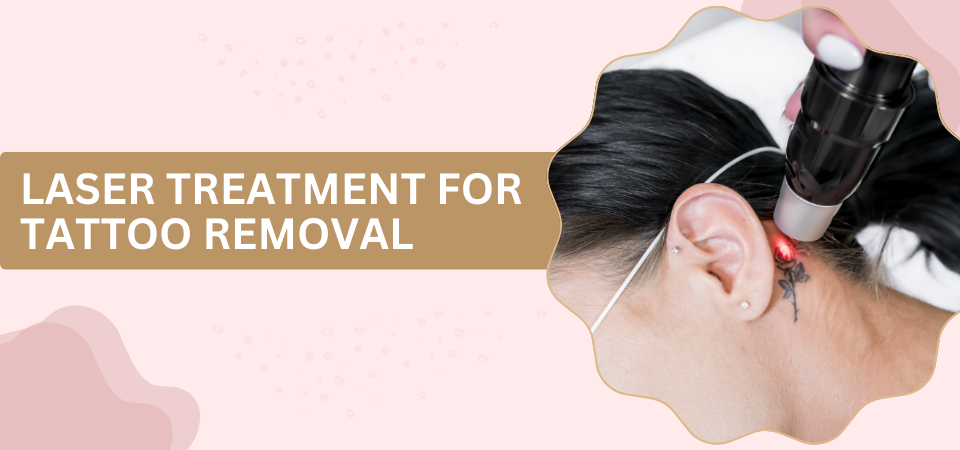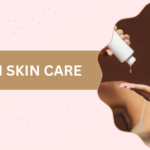
Top Monsoon Skincare Tips for Dewy Skin
July 5, 2024
Balding at 18: Understanding and Addressing Early Hair Loss
August 3, 2024
Tattoos can be beautiful, but sometimes, people decide they no longer want them. Many seek effective solutions for tattoo removal due to changes in personal taste, lifestyle, or other reasons. Laser Treatment for Tattoo Removal is one of the most advanced methods available today. It offers a precise and non-invasive option for removing unwanted tattoos.
Dr. Anju Methil, an acclaimed dermatologist in Andheri, Mumbai, with over 28 years of experience, is a leading expert in this field. At the Skin & Shape Clinic, she offers state-of-the-art laser treatment for tattoo removal. Each treatment is tailored to the individual’s skin type and tattoo characteristics. This ensures the best possible outcomes with minimal risk.
Are you concerned about the safety of tattoo removal? Let’s explore this important topic next.
Is Tattoo Removal Safe?
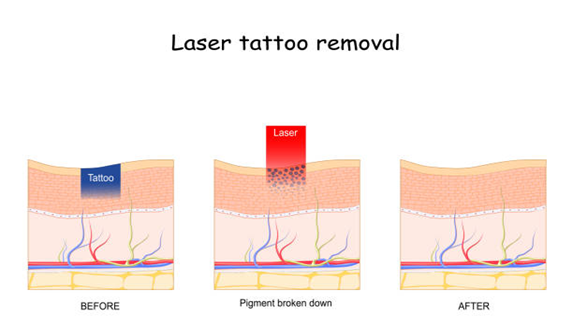
Laser treatment for tattoo removal is generally considered safe when performed by a qualified professional. The laser targets the ink particles in the skin, breaking them down so the body can naturally eliminate them. This method minimizes damage to the surrounding skin, reducing the risk of scarring or infection.
Dr. Anju Methil emphasizes the importance of choosing a reputable clinic with experienced practitioners. “Safety is paramount in any cosmetic procedure,” she says. “With the right technology and expertise, laser treatment for tattoo removal can be safe and effective.
Experience safe and effective laser treatment for tattoo removal? Consult a certified dermatologist today.
Now, let’s see how the laser tattoo removal process works.
Steps Involved in Laser Treatment for Tattoo Removal
- Initial Consultation:
- Medical History Review: The dermatologist reviews your medical history, including skin conditions, medications, and overall health, to ensure suitability for laser treatment for tattoo removal.
- Tattoo Assessment: This involves evaluating the tattoo’s size, colour, location, and age and discussing your goals and expectations.
2. Patch Test:
- Skin Reaction Test: A small tattoo area is treated with a laser to assess how your skin reacts.
- Allergy Check: Ensure there are no adverse reactions to the laser.
3. Pre-Treatment Preparation:
- Numbing Cream Application: A topical anesthetic is applied to minimize discomfort.
- Protective Gear: The patient and dermatologist wear protective eyewear to shield against the laser light.
4. Laser Treatment Sessions:
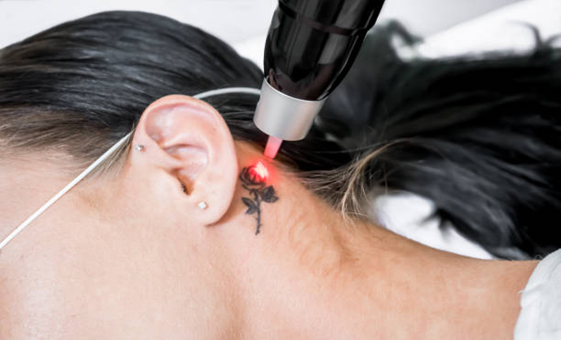
- Laser Application: The dermatologist uses a specialized laser to break down the tattoo ink into tiny particles.
- Multiple Sessions: Depending on the tattoo’s characteristics, 6-10 sessions, spaced 6-8 weeks apart, are typically required.
5. Post-Treatment Care:
- Immediate Aftercare: The treated area is covered with a soothing ointment to protect against infection.
- Avoid Sun Exposure: Protect the area from sunlight to prevent hyperpigmentation.
- Follow-Up Instructions: The dermatologist provides aftercare instructions to ensure proper healing.
6. Monitoring and Adjustments:
- Progress Evaluation: The dermatologist monitors progress during follow-up visits and adjusts the treatment plan as needed.
- Patient Feedback: Your feedback on pain and healing helps tailor the treatment for optimal results.
Eager to start your tattoo removal journey? Book an appointment with a skilled expert now.
Is Laser Treatment for Tattoo Removal Painful?
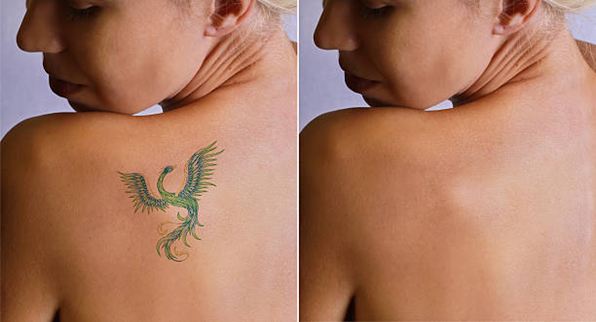
The discomfort felt during laser tattoo removal varies from person to person. Many compare it to the sensation of a rubber band snapping against the skin. Some areas of the body are more sensitive than others. So, the level of discomfort can depend on the tattoo’s location.
To minimize pain, practitioners may use numbing creams or cooling devices during the procedure. Patients may experience mild tenderness post-treatment. However, it typically subsides within a few days. Proper aftercare can also help manage discomfort and promote healing.
Now, let’s explore the factors that influence the success of tattoo removal.
What Factors Affect Laser Treatment for Tattoo Removal?
Several factors influence the effectiveness and outcome of laser tattoo removal:
- Tattoo Size and Color: Larger tattoos and specific colours (like green and blue) can be more challenging to remove.
- Age of the Tattoo: Older tattoos might fade more quickly than newer ones due to the natural breakdown of ink.
- Skin Type: Skin tone and texture affect how well the laser targets and breaks down the ink particles.
- Ink Depth: Deeper ink penetration requires more sessions to achieve the desired results.
- Location on Body: Tattoos near the heart and in areas with good blood circulation tend to fade faster.
- Health and Immune System: A strong immune system helps clear broken-down ink particles from the body.
- Aftercare: Proper post-treatment care, including sun protection and moisturizing, influences healing and final results.
Understanding these factors helps manage expectations and optimize the tattoo removal outcomes.
How Long Does Laser Tattoo Removal Take to Heal?
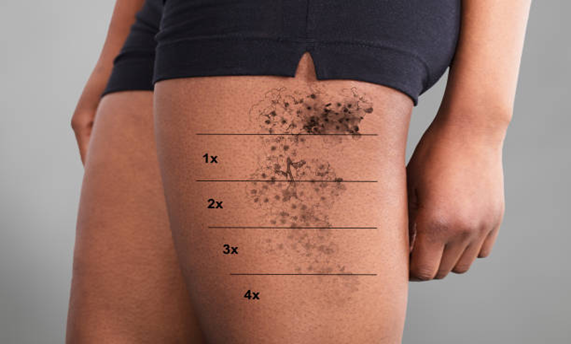
The healing time after laser tattoo removal varies depending on several factors, including the tattoo’s size and individual skin response. Typically, the initial healing phase takes about one to two weeks. The treated area may feel tender and appear red or swollen during this period.
Dr. Anju Methil, an esteemed skin specialist in Andheri, Mumbai, advises patients to follow specific aftercare instructions to promote healing and prevent complications. This includes keeping the area clean, avoiding sun exposure, and applying any prescribed ointments. Complete healing and fading of the tattoo can take several months to a year. It depends on the tattoo’s characteristics and the individual’s skin.
Are you concerned about scarring after tattoo removal? Let’s address this concern.
Does Laser Treatment for Tattoo Removal Leave a Scar?
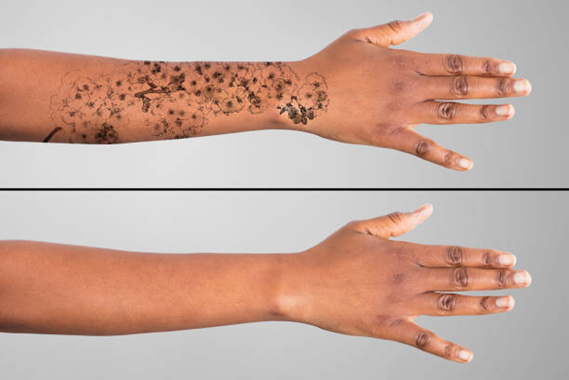
One common concern about tattoo removal is the risk of scarring. Modern laser techniques significantly reduce this risk. When performed correctly by an experienced dermatologist, laser tattoo removal is unlikely to cause scarring. The laser precisely targets the ink particles without causing extensive damage to the surrounding skin.
However, pre-existing scars from the tattoo or improper aftercare can affect the outcome. In some cases, slight changes in skin texture or pigmentation can occur, but these are usually temporary. Regular follow-ups help manage and mitigate any concerns.
Want scar-free tattoo removal results? Schedule a consultation with an experienced skin specialist today.
Conclusion
Laser treatment for tattoo removal is a safe and effective option for removing unwanted tattoos. With advanced techniques and the expertise of professionals like Dr. Anju Methil, patients can achieve clear skin with minimal discomfort and risk.
Do you have more questions about laser tattoo removal? Let’s address some common queries.
Frequently Asked Questions:
Is laser tattoo removal good for skin?
Laser tattoo removal is safe for the skin when performed by a qualified dermatologist. It targets the ink without damaging surrounding tissues.
Can tattoos be 100% removed?
Complete removal is possible for many tattoos, though results vary. Some tattoos may leave faint traces or slight skin variations.
Are old tattoos harder to remove?
Older tattoos often respond better to laser treatments. The ink has naturally faded over time, making it easier to break down.
Can pregnant or breastfeeding women undergo tattoo removal?
Generally, experts advise avoiding laser tattoo removal during pregnancy and breastfeeding due to potential risks.
Can I get a new tattoo over an area treated with laser removal?
Once the skin has fully healed and sufficiently faded, you can get a new tattoo over the treated area.

